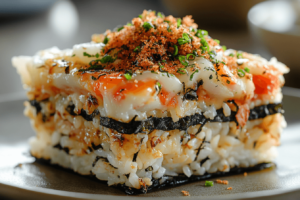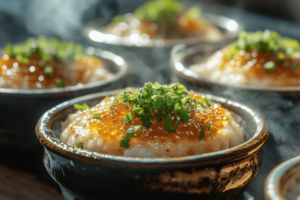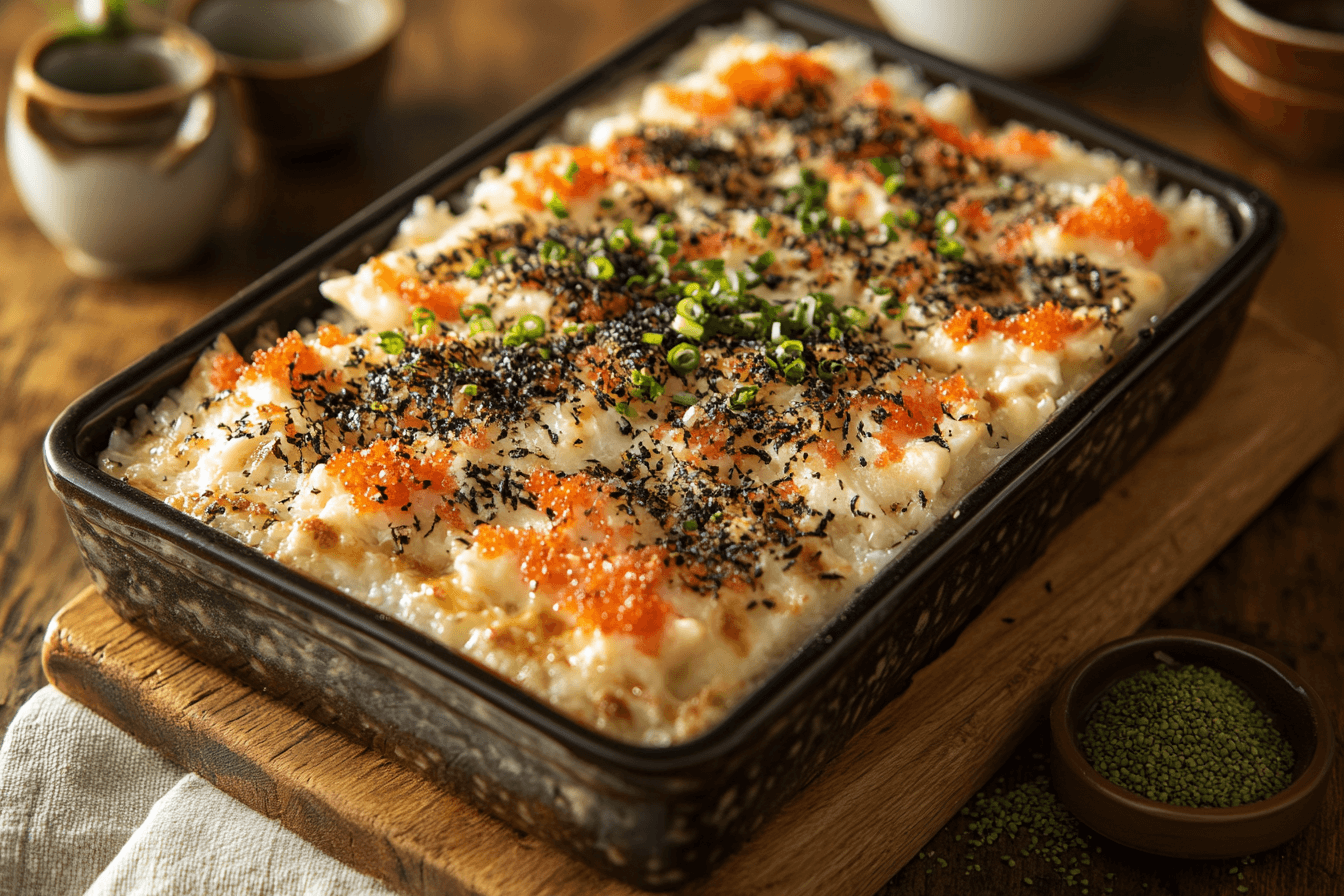Introduction
Sushi bake is a fun and tasty twist on classic sushi. It is warm, savory, and layered with traditional sushi ingredients. Many people enjoy this dish at parties or family gatherings because it is easy to share. Yet, there is often curiosity about one important question: Where is sushi bake from?
Some believe sushi bake comes straight from Japan. Others think it is a modern fusion that takes inspiration from different cuisines. Regardless of its exact beginnings, sushi bake has won hearts around the world. People praise it for its creamy flavors, simple preparation methods, and ability to feed a crowd.
In this article, we will explore the origin of sushi bake, its key components, and the reasons for its growing popularity. Furthermore, we will break down its cultural connections and discuss why you might want to add it to your dinner table. We will also address common questions about this dish in a frequently asked questions section. Finally, you will discover tips and ideas for making your own delicious sushi bake.
Keep reading, and you will learn how sushi bake has evolved from a humble recipe into a global comfort food. Moreover, you will gain insight into the various influences that shaped this layered delight. Enjoy this friendly yet professional guide that will uncover the real story behind sushi bake.
Sushi Bake: Tracing Its Origin
Sushi bake has become a star dish at many events. But before diving into its tasty layers, it helps to know where it actually comes from. To understand this, we need to look at the evolution of modern sushi and how different culinary traditions gave rise to creative versions of this famous Japanese staple.
A Quick Look at Traditional Sushi
Traditional sushi is often linked with Japan. It generally consists of vinegared rice topped with fresh fish or other seafood. When people ask, “Where is sushi from China or Japan?” the short answer is Japan. However, there is some debate because the technique of preserving fish with salted rice may have started in parts of ancient China. But in its modern form, sushi is strongly associated with Japan. This Japanese style of seasoned rice and fresh seafood is the foundation of many fusion dishes we see today, including sushi bake.
Bringing in Filipino Influences
A closer look at sushi bake reveals that it is not purely Japanese. Many believe sushi bake actually started in the Philippines or among Filipino communities. People in these areas combined the baked casserole idea with sushi ingredients. This mix of Japanese elements and Filipino comfort food techniques led to a tasty new creation. Thus, it is often considered a Filipino-inspired dish with Japanese roots.

Because of this cultural mix, sushi bake features a rich and layered profile. It merges creamy sauces, savory toppings, and seasoned rice. In the Philippines, dishes like baked spaghetti and other layered casseroles are popular. In turn, the idea of baking sushi in a pan seems like a logical development. This approach keeps things simple, while still delivering bold flavors.
Where Does Sushi Bake Come From?
So, is sushi bake from Japan? Or is it a Filipino invention? The answer involves a bit of both. It borrows sushi’s classic flavors and pairs them with a casserole approach that many Filipinos enjoy. While precise documentation of its first appearance may be hard to find, it is likely that home cooks started experimenting. They layered sushi ingredients in trays for potlucks and parties, then popped them in the oven for a warm, crowd-pleasing treat. Over time, sushi bake gained so much popularity that it became a trendy dish on social media.
Moreover, its presence in Filipino-American communities in the United States boosted its fame. Soon, the rest of the world caught on. With a few online searches, home cooks discovered easy recipes, which further spread its popularity. Therefore, the dish’s widespread appeal can be traced to both its Japanese-inspired ingredients and its Filipino baking traditions.
How Sushi Bake Evolved Into a Global Favorite
Now that we have addressed the question, Where is sushi bake from?, it is time to see how this once modest dish turned into a worldwide sensation. It did not take long for sushi bake to become a staple at gatherings. Today, it has gone beyond Filipino communities and entered mainstream dining in the U.S. and beyond.
Social Media and Sushi Bake
One reason for sushi bake’s rapid rise in popularity is social media. Food influencers, bloggers, and home chefs shared countless photos and short clips of their versions. This visual exposure sparked curiosity among viewers who may not have heard of it before. Meanwhile, the method of preparing sushi bake made it more approachable than regular sushi. Traditional sushi can be tricky to make. You need special knife skills, fresh fish, and an understanding of rolling techniques. By contrast, sushi bake only needs layering and baking, which is simpler.
Additionally, the shareable nature of sushi bake videos allowed viewers to see just how easy it is to assemble. Another factor is the comfort-food appeal of warm, cheesy, and hearty dishes in American culture. Sushi bake fits right in, offering an easy crowd-pleaser that is layered in a casserole dish. Indeed, it is often referred to as a “baked sushi casserole,” which highlights its cozy and wholesome vibe.
Fusion Cuisine Boom
In recent years, fusion cuisine has become a trend. People are more open to new flavor combinations and global influences. Sushi bake is a prime example of this shift. It merges distinct culinary traditions to create something fresh. This openness to experimentation allowed sushi bake to flourish. In addition, it caters to various dietary choices, since you can swap out fillings or use alternative ingredients. Thus, it has become adaptable for many lifestyles and cultural preferences.
Beyond the Traditional Flavors
While classic sushi bake includes white rice, crab sticks, mayonnaise, fish roe, and perhaps some cucumber, creative cooks have taken the idea further. Some replace crab sticks with salmon or tuna. Others add avocado, sriracha, and even cream cheese. These additions result in countless mouthwatering variations. Moreover, the dish lends itself to different toppings and sauces. As a result, sushi bake can be customized to suit local ingredients and personal tastes.
Key Elements of Sushi Bake
Understanding the core components of sushi bake helps reveal why it tastes so good. Furthermore, it shows how this dish builds upon traditional sushi, yet remains unique.

Rice Layer
At the bottom of most sushi bake recipes is a layer of seasoned rice. Often, short-grain Japanese rice is used. It is sticky, which makes it easy to mold into a base. But any rice that can absorb flavor will work. Vinegar, sugar, and salt typically season the rice, much like classic sushi. This seasoning brings a subtle tang that balances the richness of the toppings.
Creamy Spread
Next is a creamy mixture that usually includes shredded or chopped seafood. Imitation crab sticks are a popular choice, but real crab or flaked salmon also works. This mixture is blended with mayonnaise, sometimes cream cheese, and a bit of seasoning or spice. The result is a luxurious, savory spread that pairs well with the vinegared rice.
Toppings
Finally, sushi bake is often topped with furikake (a Japanese seasoning mix with seaweed and sesame), roe, and additional sauces. Some versions drizzle sriracha or a spicy mayo on top. Others sprinkle green onions for extra color and taste. Many also add unagi sauce or soy sauce. These final layers create visual appeal and impart a burst of umami flavor.
The combination of these layers—rice, creamy seafood mixture, and toppings—captures the essence of sushi. However, the use of an oven to bake everything turns it into a casserole-like dish. This step is a big departure from how traditional sushi is served. Still, it offers a unique twist that many find irresistible.
Why Sushi Bake Appeals to American Palates
Although sushi bake might have originated in the Philippines, it has gained a huge following in the United States. Americans love easy comfort food, and sushi bake checks that box. In addition, it delivers familiar flavors—creamy mayonnaise, sweet and salty sauces, and hearty rice. These components fit well with the American love for casseroles and baked dishes.
Moreover, it is a dish that can accommodate large gatherings. It does not require the intricate assembly that individual sushi rolls demand. One large tray can feed many people. Therefore, it is great for potlucks, holidays, and casual get-togethers. Since it is served warm, it also aligns with the American preference for hot, satisfying meals.
Finally, the playful nature of sushi bake encourages creativity. People can add, remove, or swap ingredients to match personal taste or dietary needs. That sense of freedom and accessibility is appealing to many home cooks, who are always eager to put their own spin on a trendy dish.
Step-by-Step Guide to Making Sushi Bake
If you are excited about trying sushi bake at home, you are in for a treat. The process is straightforward, and the ingredients are easy to find. Below is a simple step-by-step guide for anyone looking to bring this fusion dish to life in their own kitchen.
- Prepare the Rice
Cook Japanese short-grain rice according to package instructions. Then, while the rice is still warm, gently mix in rice vinegar, sugar, and salt. Spread the rice evenly in a baking dish that can hold all layers. - Make the Creamy Seafood Layer
Shred or chop imitation crab sticks (or your preferred seafood). Place them in a bowl and add mayonnaise, softened cream cheese, and a dash of seasonings like pepper or garlic powder. Gently stir until smooth. Spread this mixture over the rice layer. - Add Toppings
Sprinkle furikake, seaweed flakes, or toasted sesame seeds over the creamy layer. Add fish roe if you like a pop of color and flavor. Drizzle sriracha or spicy mayo for heat. Feel free to experiment here with your favorite toppings. - Bake in the Oven
Preheat your oven to around 375°F (190°C). Place the baking dish inside for about 10 to 15 minutes, or until the top is golden and bubbly. Carefully remove it from the oven once it looks nicely toasted. - Serve and Enjoy
Sushi bake is usually served hot or warm. You can scoop it onto small sheets of roasted seaweed (nori) to mimic sushi rolls. Add a slice of avocado or cucumber for extra crunch and flavor. Then, top it with more sauce if desired.
This easy approach helps you create a restaurant-quality dish. Even people who have never tried making sushi will find it quite manageable.
Serving and Storing Sushi Bake
While some people love the classic cold taste of sushi, sushi bake is typically eaten warm. That is one of the reasons it stands out and prompts questions such as, “Are you supposed to eat sushi bake hot or cold?” The answer is that it is best served warm right out of the oven. However, you can also enjoy leftovers cold if you prefer. The flavors remain tasty, although the texture is different when chilled.
To store leftover sushi bake, cover it tightly and place it in the refrigerator. It can remain fresh for about two to three days. When ready to eat again, you can reheat it in the oven or microwave for a warm meal. If you want to keep some of that crisp top layer, the oven is the better choice. You may want to add a small drizzle of water over the rice to keep it from drying out.

Frequently Asked Questions
Are you supposed to eat sushi bake hot or cold?
Sushi bake is generally served hot or warm. Many people prefer it straight out of the oven because it highlights the creamy texture. Still, it is safe to eat cold. But you will notice a difference in texture.
Where is sushi from China or Japan?
Sushi is mostly associated with Japan. Although there are older forms of preserved fish in China, modern sushi as we know it today was popularized and refined in Japan.
Is baked sushi from Japan?
Traditional sushi comes from Japan. However, baked sushi, or sushi bake, likely originated through Filipino-American fusion cooking. It blends Japanese flavors with a comforting casserole style.
Where does sushi bake come from?
Sushi bake is believed to come from the Philippines or Filipino-American communities. It merges classic sushi components with a baked casserole method. This layered dish has since spread globally.
Conclusion
Sushi bake might trace its roots to Japanese cuisine. Yet, it was shaped by Filipino food culture and further popularized worldwide by social media. It is an example of how culinary trends can cross borders, evolve, and become crowd favorites. By blending the flavors of sushi with a warm and cozy casserole technique, sushi bake delivers a unique dish that appeals to many tastes.
Furthermore, the flexibility of sushi bake makes it easy to adapt. You can stick to classic ingredients or explore new flavors. The result is a comforting, shareable meal that is just as at home at family gatherings as it is at upscale parties. Now that you know where sushi bake is from, you can better appreciate the cultural layers behind every flavorful bite. And whether you serve it hot or cold, this dish is sure to delight. Enjoy creating and sharing your very own sushi bake at home.

